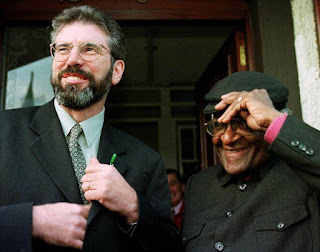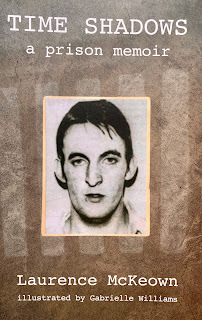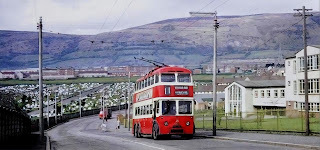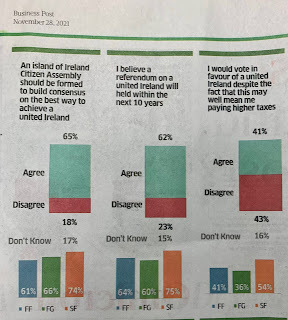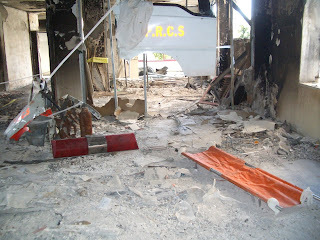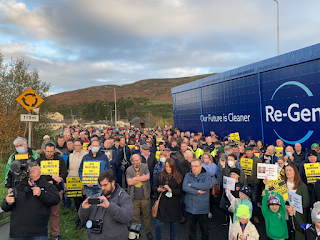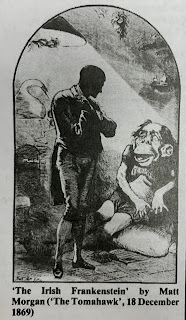Gerry Adams's Blog, page 19
January 10, 2022
Desmond Tutu: Tom’s a Singer
Desmond Tutu
I had the honour and pleasure of meeting Desmond Tutu over the years. He was a friend of Ireland and a supporter of the Irish peace process. He was a remarkable, compassionate and inspirational human being. He never compromised on his belief in the essential goodness of people or on the imperative of dialogue as the means of resolving differences.
In Irish there is a saying: “Is ar scáth a chéile a mhaireann na daoine” which translates as: “We all live in each other’s shadow.” Few people understood the essence of this connectivity between people better than Archbishop Tutu. It was a fundamental part of his religious faith and of his humanity. He worked for a better South Africa and for a better world. As an internationalist he welcomed the solidarity of others for the people of South Africa in their struggle against apartheid.
In 1984 as he travelled to Oslo to receive his Nobel Peace Prize Archbishop Tutu stopped briefly in London where he met Karen Gearon and Mary Manning, two of the Dunnes Stores strikers who were refusing to handle South African products. He applauded their solidarity. The efforts of the Dunnes Stores’ workers and others eventually forced the Irish government to ban South African goods.
Seven years later, in April 1991, Desmond Tutu was back in Ireland to meet with Anglican Church leaders and to take part in the annual Louisburg ‘famine’ walk in Mayo. During his visit Archbishop Tutu commented on efforts at that time to establish a talks process in the North. Drawing from his South African experience Desmond Tutu advised: ‘Let your negotiations be as inclusive as possible. Don’t let any feel they’ve been excluded. Let them be represented by those they regard as their authentic spokespersons, otherwise talks, as we have discovered at home, become an exercise in futility.’
The British and Irish governments and most of the Church leaders ignored his advice and the talks process collapsed. It was another six years before inclusive all-party negotiations commenced in September 1997.
As an internationalist the Archbishop was equally vocal in his opposition to the apartheid policies of the Israeli state and its ill-treatment of the Palestinian people. This aspect of his public work was also largely opposed by many in the political establishments and in the media. They failed to support him on these issues while he was campaigning on them. Yet after his death they praised him for his courage and vision.
The Boycott, Divestment and Sanctions (BDS) movement for Palestinian rights was established in 2005. Archbishop Tutu was among the first to endorse its strategy and efforts. In March 2014 Archbishop Tutu reflected on the role that boycotts and divestment played in encouraging world governments to end their support for the White apartheid regime; “The same issues of inequality and injustice today motivate the divestment movement trying to end Israel's decades-long occupation of Palestinian territory and the unfair and prejudicial treatment of the Palestinian people by the Israeli government ruling over them.’
Desmond Tutu’s internationalism, compassion and humanity also saw him speak out against other forms of injustice and inequality and the threat posed by climate change. Only two months ago he took part in a United Nations campaign against homophobia and transphobia.
The death of Archbishop Tutu has silenced a voice of reason for a kinder, more caring, just and empathetic society. His courage through decades of struggle and his determined support for human rights and especially for the people of Palestine is a challenge to the international community.
I extend my condolences to the people of South Africa, to President Cyril Ramaphosa, and to Archbishop Tutu’s family.
Tom’s a Singer
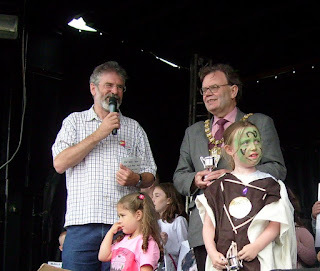
Our old pal Tom Hartley is a fine singer. He and I have been known to duet together. Back in the day in C Wing in Belfast Prison on the Crumlin Road, his dulcet tones echoed around the landings like a bird in flight while my rich baritone kept close harmony. Our sonorous grace notes soared and dipped in perfect tune. Even now decades later, men locked in the loneliness of their cells at that time, and recalling nowadays how they were transfixed by the magical quality of our voices, will shed a tear at this musical memory. I even remember Prison Officers being moved by these moments. Tom always said he couldn’t abide mediocrity.
And that certainly is the case as far as his singing was concerned. The Creggan White Hare bounded freely along the prison landings. To be followed by the poignant tale of Sliabh Gallion Braes. For a few liberating minutes we were all free from the melancholy of the Crum and transported by the strength and melodiousness of song into another place. That’s where the Blues come from. From the slave plantations and prisons. From the chain gangs. Or in our case the latrines in C Wing.
Tom’s musical roots go deep. A pioneer - though not of the abstemious kind - of music sessions and a traveler to fleadhs when the best seisuns were on the Monday or Tuesday after the visitors had gone home. Tom is steeped in ceol. That was the sixties. Away back in 1969 and behind the barricades I recall he and I and some friends sharing the new recording of O Riada Sa Gaiety. We were in Tom McGoldrick’s mother’s parlour and we were all enthralled by this new confident presentation of traditional music. Here was our music outted from the backrooms and kitchens and halting sites or the corners of fair grounds or entrances to GAA pitches.
Two recent RTE programmes brought all this back to me. Cosc - Seven Drunken Nights the story of how the Dubliners got on to Top of The Pops and The Flourishing, which is a wonderful televisual journey back into those days of our folk revival. Seven Drunken Nights was an English language version of Peigín agus Peadar recorded by traditional singer Seosamh Ó hÉanaigh years earlier and given by him to Ronnie Drew in O’Donoghue’s pub one night. When The Dubliners released Seven Drunken Nights as a single it battled its way into the English charts in 1967 along with The Beatles, The Rolling Stones, Jimi Hendrix and the Kinks.
Back in Dublin RTE banned them from the airwaves. Because their song is about an unfaithful wife. Too sexually explicit for the ‘national’- mar dhea - broadcaster. When news of this broke the song went immediately to Number One in the Irish charts. The people approved.
Seosamh Ó hÉanaigh wistfully remarked that his Peigín agus Peadar was never banned. It continued to be heard on the airwaves. Apparently without offending anyone.
The Flourishing reflects on the emergence of our music from the ‘underground’ into the foreground and mainstream in the sixties and seventies. It is a terrific documentary.
It reminded me that traditional music was sustained by families steeped in the tradition, including the Traveller Community who deserve great credit for keeping our song and music alive. Comhaltas Ceoltóiri Éireann also deserve great credit. And the people of the Gaeltacht communities. So too our exiled children in America. Following the shameful disappointment of the post revolutionary period and the awfulness and savagery of the civil war and the enforcement of partition the mass exodus of Irish people included musicians from all parts of our island, many with their own styles and local sets. Some of the more prominent of them recorded these tunes.
Others recorded nationalistic or republican songs. They included The Clancy Brothers and Tommy Makem. Slowly these recordings travelled back home. The 50th Anniversary of the 1916 Rising saw them increase in popularity and the emergence of ballad seasons and ballad groups.
The traditional music revival took a huge leap forward with Seán Ó Riada’ s musical soundtrack for Mise Éire, George Morrison’s film about the 1916 Rising. O Riada was a musical visionary freed from the neo colonial cultural amnesia of his time. He was proud of our culture and had the vision and talent to reboot it and bring it to audiences who embraced it also with pride. They included young musicians who stayed true to the tradition while fusing it with their own genius. Pipers, box players, fiddlers, fluters, harpers, tin whistlers. Even the humble bodhrán came into its own. And singers in Irish and English. And seán nós dancers.
Our pal Tom was useless at dancing. He still is. Ted is our Michael Flatley. Agus mise fhéin.
Not everyone appreciated our singing. Once in Grosvenor Road RUC Barracks the RUC took grave exception to our rendition of The Oul Triangle. I suppose hearing it twenty seven times without pause can be trying. They threw us out.
‘We wanted you to sing’ said the Duty Sergeant. ‘But not like that. Get out of here and give our heads peace.’
Tom stood in front of him. Legs apart. Shoulders back. Chest out. He smiled angelically, put his hand up to his ear. He closed his eyes, cocked his head back and turned his face upwards. He beckoned me to join him. As I did he put his other hand on my shoulder. We let our voices ring out.
‘A hungry feeling came o’er me stealing. The mice lay squealing in my prison cell …’
‘Get out,’ the RUC man screamed at us.
So we did.
Our pal Tom used to make bodhráns. He played them also. I have one of his original drums. He used goatskins. They stunk to the heavens when he was drying them out. Incidentally he got some of the tricks of bodhrán making from an old man in Sandy Row who also made Lambeg drums. Music unites us all.
So there you have it. Let the music keep your spirits high.
January 3, 2022
New Year Resolutions: Charities - supporting the vulnerable: Back to basics: Books for the New Year
New Year Resolutions.
New Year resolutions and I are old friends. Usually I muse at the end of the old year about what I need to commit myself to for new year’s arrival. This year the pandemic cuts down the options. Going to the gym isn't on. Taking up senior hurling or football? Same problem. Stopping the drink? Maybe? But seeing as I am fairly sober most of the time it would be going too far not to have a wee deoch every so often. For medicinal purposes.
Being a better person? That’s a daily effort. Staying out of trouble? Impossible? Giving up twitter? Being more serious all the time? Acting my age? Nawh! To paraphrase Emma Goldman, ‘If I can’t act the eejit I don't want to be part of the revolution.’ So my New Year resolution this year is not to make a new year resolution.
I remember once making a new year resolution to stop smoking. I used to smoke a lot. So did most people. How stupid we were. I smoked everything that was legal. Cigarettes. Cigars. The pipe. I used to give them up all the time. I got very good at it. Then I would lapse again. Around this time children got a lot of education about the perils of smoking. They included our oldest lad Gearóid. He became an anti- smoking zealot. He would return from school on a daily basis with some new data of the health hazards of nicotine and harangue me and his mother about our bad habits. Eventually he got through to me and one New Years Eve I made a resolution to quit smoking.
So I did. Gearóid was proud of me. This was before he reached the juvenile sceptical phase that most young boys go through with their fathers. So I was chuffed. And I was also in a morally superior position in contrast to his still smoking mother. A rare and unique position for any mere man.
Then I broke. I used to sneak a wee puff every so often. I didn't tell anyone. I secreted my toitiní and when no one was about I indulged myself. My New Year Resolution was kaput. I took to going to the bathroom for a quiet smoke. One day I was seated there on the throne with my trousers around my ankles puffing contently away. But I had neglected to lock the toilet door.
Suddenly it burst open as our oldest lad dashed in to relieve himself. I was caught. The look of disbelief and disappointment on his face as he spied the feg in my gob cut me to the quick. He fled before I could say anything. I was ashamed of myself. I had let him down. I flushed my cigarette away. That was the last time I smoked.
So make New Year’s resolutions if that is your wish. It can’t do any harm. If you fail? No matter. I’m with Samuel Beckett. Fail again. Fail better.
Bliain Úr Faoi Mhaise Daoibh.
Charities - supporting the vulnerable
In Dublin on the Tuesday before Christmas an estimated three thousand women and men began queuing in the cold and dark of a bleak December morning outside the Capuchin Day Centre. For years now the Centre has provided food parcels for the homeless, the unemployed and the low paid. This year the demand was so great that instead they gave the thousands who turned up a 50 euro voucher for food and clothes. In Belfast food banks were running low and local community organisations, including Sinn Féin, provided food parcels and supports to those in need. The demand was greater than the supply.
Other charities provide different and unique services for those with disabilities or mental health or medical issues or support our elderly. Thousands of volunteers are the backbone of all of these charities and they deserve our thanks for the work they do. For most of them their work isn't just for Christmas. It’s all year round. Míle buiochas.
Back to basics
Captain Jack Doyle in Sean O’Casey’s “Juno and the Paycock” has a word for it – ‘chassis.’ He says: “I’m telling you … Joxer …th’ whole worl’s … in a terr … ible state o’ … chassis.”
Whether its chassis or chaos or just plain shambles 2022 begins with DUP leader Jeffrey Donaldson renewing his threat to pull down the political institutions. The DUP demand that the Protocol, a least worse option for protecting jobs and businesses in the North, must go. I’ve lost count of how many times he has made this threat.
According to the DUP the “people of Northern Ireland” demand it. Of course, the truth is they don’t. The majority voted against Brexit. All of the other parties to the Executive are against pulling the institutions down. But the DUP same intent on whipping up a crisis intended to help them in an upcoming election battle.
At the same time their erstwhile ally Boris Johnson – who they lauded and fawned over – and who negotiated the said Protocol – has his own troubles. Chassis is a good word to describe his multiple crises. Where to begin? There is the sleaze scandal over money for lobbying which saw Owen Patterson, a former appalling Secretary of State for the North, forced to resign. I never had much time for him. The Tories then lost in spectacular fashion the seat they had held in North Shropshire for 200 years. And then there are the Downing Street parties. While everyone else was in lockdown because of Covid Johnson’s minions were partying it up in Number 10 and their press people were caught on camera joking about it.
Brexit too – which brought Johnson to power just two years ago with a whopping 80 seat majority – has turned on him. The British economy is not doing well; they still have no US trade deal; and the Brexit Minister – David Frost - resigned from the Cabinet just weeks ago. And to top it all up Labour is ahead in the polls for the first time in years.
So, in a time of chassis what we need are cool heads and thoughtful responses to events as they unfold. 2022 will also be an opportunity for United Irelanders to ratchet up our alternative vision for the island of Ireland and to win new converts to proposals for the Irish Government to set up a Citizens Assembly and the Unity Referendum.
2021 saw important progress on this. Let’s keep it going. Na h’abair é. Dean é.
Many of us are either given or give book vouchers to family and friends for Christmas. And even if you don’t have book vouchers there are some excellent books available now written from a broadly republican and progressive perspective. Little wonder the British Government is setting up an official revisionist ‘history’. Methinks they are too late.
Here are just a few of my recommendations. All and many more are available through www.sinnfeinbookshop.com and An Fhuiseog 55 Falls Road,
Time Shadows- a prison memoir by Laurence McKeown
6000 Days by Jim (Jaz) McCann
On Dangerous Ground, A Memoir of the Irish Revolution, Máire Comerford Edited by Hilary Dully
Ireland, Colonialism and the Unfinished Revolution by Robbie McVeigh and Bill Rolston
Inside and Out, A book of poetry by Gerry Kelly
Pluid by Eoghan MacCormaic
Ón Taobh Istigh by Jake MacSiacais.
No Ordinary Women by Sinéad McCoole
December 27, 2021
Nollag shona daoibhse: Leonard Peltier ��� An appeal for Compassion: A New Year Resolution for a Citizens��� Assembly.
Nollag shona daoibhse.
I like Christmas. I like the Christmas story. Joseph and Mary and the wee donkey fleeing from the Roman occupation forces. The baby Jesus being born in a stable. I marvel about the impact of Jesus Christ in this human world and I still believe in his teaching. I no longer have any confidence in the institutional Christian churches but I do value the efforts of many priests and nuns to bring justice to a divided world.
I like the simplicity of Christmas. Daddy and Mammy Christmas, the elves. The joy that little children bring. I like Christmas carols. And my Christmas dinner. I dislike the stress that Christmas means for some people. I detest the commercialism and exploitive activities that accompanies this festive time. My heart goes out to those less fortunate than me.
Like most everyone else I remember old pals and family members who are no longer with us and I enjoy raising a glass to their memory. And another glass for my many blessings.
So have as good and as peaceful a Christmas as you can in these pandemic times. Stay safe and embrace the pandemic regulations. And remember, this too will pass. Bliain ��r Faoi Mhaise Daoibhse.
Leonard Peltier ��� An appeal for Compassion
This Christmas take a moment to think about Leonard Peltier. Leonard was convicted in 1977 of the murder of two FBI agents during a confrontation at the Pine Ridge Reservation in South Dakota. Two others who were charged with the murders were found not-guilty by reason of self-defence. Peltier has always denied involvement in the two deaths. He has been in prison for almost 45 years.
In the years since then serious and significant questions have arisen over the evidence produced by the prosecution at the trial. A witness who recanted her account claimed she had been forced into making a statement by the FBI. A ballistics expert who linked Peltier���s weapon to the murders was reprimanded by the federal court for lying.
In July this year James H. Reynolds the former US Attorney General whose office handled the prosecution and appeal in the Leonard Peltier case appealed for his sentence to be commuted. In a letter to President Biden he said: ���With time, and the benefit of hindsight, I have realized that the prosecution and continued incarceration of Mr. Peltier was and is unjust.���
In October Amnesty International issued an Urgent Action notice calling for clemency for Leonard Peltier. Amnesty pointed out that, ���Leonard Peltier has been imprisoned in the USA for over 44 years, some of which was spent in solitary confinement, serving two life sentences for murder despite concerns over the fairness of his trial. He has always maintained his innocence. He is 77 years old and suffers from a number of chronic health ailments, including one that is potentially fatal.���
Amnesty International has asked that President Biden grant Leonard Peltier clemency on ���humanitarian grounds and as a matter of justice.��� The human rights organisaiton has asked people to write to President Biden.
Several weeks ago I did just that. I wrote to President Biden urging him to release Leonard Peltier on ���compassionate grounds.���
I said: ���Leonard has been imprisoned for almost 45 years and has served more time than the presumptive maximum federal sentence��� Leonard has always protested his innocence.���
I also quoted the view of James H. Reynolds and said: ���In August former Federal Judge Kevin H. Sharp who is currently Leonard Peltier���s clemency lawyer filed a new clemency petition with the Department of Justice.
In October U.S. Congress members - Ra��l M. Grijalva, Barbara Lee, Jes��s G. ���Chuy��� Garcia, Cori Bush, Emanuel Cleaver II, Jared Huffman, Teresa Leger Fern��ndez, Rashida Tlaib, Pramila Jayapal, Betty McCollum, and Melanie Stansbury ��� wrote a joint letter to you requesting the ���expedited release of Leonard Peltier from the Coleman Federal Correctional Complex in Florida and request that Mr. Peltier be granted clemency.���
Calls for Leonard Peltier���s release have also been supported by international figures, including the late Nelson Mandela; former Irish President Mary Robinson and Archbishop Tutu.
Join us in urging compassion and clemency for Leonard Peltier. Write to:
President Joseph Biden
The White House
1600 Pennsylvania Ave NW
Washington, DC 20500, USA
A New Year Resolution for a Citizens��� Assembly.
If you take as read the normal health warning that accompanies opinion polls there is little doubt that the two latest reaffirm the public interest in the potential for Irish Unity and the need for a dialogue to commence to talk about the many issues of concern that arise for such a step to be contemplated.
It says much about the disaster that is partition that in the year of its centenary there are more people talking about its failures and the need for an all-island replacement than ever before.
However, instead of leaving it to newspapers and pollsters ��� whose questions can often negatively affect the responses ��� to ask people about new constitutional arrangements, the place of a health service, the question of flags and emblems and anthems and the cost/tax implications of Unity, let���s have a considered conversation in which those questions can be asked and expert testimony taken on what answers and solutions are available.
This requires a time-framed structured conversation, led by the Irish government, involving the setting up of a Citizens Assembly, representative of people across this island. The Irish Government has established similar bodies three times in the last decade. A Constitutional Convention was held between 2012-14, which included representation from the North; a Citizens Assembly ran between 2016-18; and a Citizens��� Assembly on Gender Equality was established in July 2019. Its report was given to the Oireachtas in June of this year.
A Citizen���s Assembly makes sense. It pays to plan for the future. So let���s have an intelligent, calm conversation on issues as diverse as governmental structures; an all-island health service; future governance arrangements; taxation; pensions and public services can be aired. Only the messers and begrudgers are suggesting that there should be a vote on unity today or tomorrow. Sensible people want space and time to talk these issues through. Had we all stuck to our respective positions ��� politicians and people alike ��� there would have been no Good Friday Agreement. Dialogue and negotiations dramatically changed that. It can do so again. That's why An Taoiseach���s New Year Resolution should be to set up a Citizens Assembly.
Nollag shona daoibhse: Leonard Peltier – An appeal for Compassion: A New Year Resolution for a Citizens’ Assembly.
Nollag shona daoibhse.
I like Christmas. I like the Christmas story. Joseph and Mary and the wee donkey fleeing from the Roman occupation forces. The baby Jesus being born in a stable. I marvel about the impact of Jesus Christ in this human world and I still believe in his teaching. I no longer have any confidence in the institutional Christian churches but I do value the efforts of many priests and nuns to bring justice to a divided world.
I like the simplicity of Christmas. Daddy and Mammy Christmas, the elves. The joy that little children bring. I like Christmas carols. And my Christmas dinner. I dislike the stress that Christmas means for some people. I detest the commercialism and exploitive activities that accompanies this festive time. My heart goes out to those less fortunate than me.
Like most everyone else I remember old pals and family members who are no longer with us and I enjoy raising a glass to their memory. And another glass for my many blessings.
So have as good and as peaceful a Christmas as you can in these pandemic times. Stay safe and embrace the pandemic regulations. And remember, this too will pass. Bliain Úr Faoi Mhaise Daoibhse.
Leonard Peltier – An appeal for Compassion
This Christmas take a moment to think about Leonard Peltier. Leonard was convicted in 1977 of the murder of two FBI agents during a confrontation at the Pine Ridge Reservation in South Dakota. Two others who were charged with the murders were found not-guilty by reason of self-defence. Peltier has always denied involvement in the two deaths. He has been in prison for almost 45 years.
In the years since then serious and significant questions have arisen over the evidence produced by the prosecution at the trial. A witness who recanted her account claimed she had been forced into making a statement by the FBI. A ballistics expert who linked Peltier’s weapon to the murders was reprimanded by the federal court for lying.
In July this year James H. Reynolds the former US Attorney General whose office handled the prosecution and appeal in the Leonard Peltier case appealed for his sentence to be commuted. In a letter to President Biden he said: “With time, and the benefit of hindsight, I have realized that the prosecution and continued incarceration of Mr. Peltier was and is unjust.”
In October Amnesty International issued an Urgent Action notice calling for clemency for Leonard Peltier. Amnesty pointed out that, “Leonard Peltier has been imprisoned in the USA for over 44 years, some of which was spent in solitary confinement, serving two life sentences for murder despite concerns over the fairness of his trial. He has always maintained his innocence. He is 77 years old and suffers from a number of chronic health ailments, including one that is potentially fatal.”
Amnesty International has asked that President Biden grant Leonard Peltier clemency on “humanitarian grounds and as a matter of justice.” The human rights organisaiton has asked people to write to President Biden.
Several weeks ago I did just that. I wrote to President Biden urging him to release Leonard Peltier on “compassionate grounds.”
I said: “Leonard has been imprisoned for almost 45 years and has served more time than the presumptive maximum federal sentence… Leonard has always protested his innocence.”
I also quoted the view of James H. Reynolds and said: “In August former Federal Judge Kevin H. Sharp who is currently Leonard Peltier’s clemency lawyer filed a new clemency petition with the Department of Justice.
In October U.S. Congress members - Raúl M. Grijalva, Barbara Lee, Jesús G. “Chuy” Garcia, Cori Bush, Emanuel Cleaver II, Jared Huffman, Teresa Leger Fernández, Rashida Tlaib, Pramila Jayapal, Betty McCollum, and Melanie Stansbury — wrote a joint letter to you requesting the “expedited release of Leonard Peltier from the Coleman Federal Correctional Complex in Florida and request that Mr. Peltier be granted clemency.”
Calls for Leonard Peltier’s release have also been supported by international figures, including the late Nelson Mandela; former Irish President Mary Robinson and Archbishop Tutu.
Join us in urging compassion and clemency for Leonard Peltier. Write to:
President Joseph Biden
The White House
1600 Pennsylvania Ave NW
Washington, DC 20500, USA
A New Year Resolution for a Citizens’ Assembly.
If you take as read the normal health warning that accompanies opinion polls there is little doubt that the two latest reaffirm the public interest in the potential for Irish Unity and the need for a dialogue to commence to talk about the many issues of concern that arise for such a step to be contemplated.
It says much about the disaster that is partition that in the year of its centenary there are more people talking about its failures and the need for an all-island replacement than ever before.
However, instead of leaving it to newspapers and pollsters – whose questions can often negatively affect the responses – to ask people about new constitutional arrangements, the place of a health service, the question of flags and emblems and anthems and the cost/tax implications of Unity, let’s have a considered conversation in which those questions can be asked and expert testimony taken on what answers and solutions are available.
This requires a time-framed structured conversation, led by the Irish government, involving the setting up of a Citizens Assembly, representative of people across this island. The Irish Government has established similar bodies three times in the last decade. A Constitutional Convention was held between 2012-14, which included representation from the North; a Citizens Assembly ran between 2016-18; and a Citizens’ Assembly on Gender Equality was established in July 2019. Its report was given to the Oireachtas in June of this year.
A Citizen’s Assembly makes sense. It pays to plan for the future. So let’s have an intelligent, calm conversation on issues as diverse as governmental structures; an all-island health service; future governance arrangements; taxation; pensions and public services can be aired. Only the messers and begrudgers are suggesting that there should be a vote on unity today or tomorrow. Sensible people want space and time to talk these issues through. Had we all stuck to our respective positions – politicians and people alike – there would have been no Good Friday Agreement. Dialogue and negotiations dramatically changed that. It can do so again. That's why An Taoiseach’s New Year Resolution should be to set up a Citizens Assembly.
December 22, 2021
The Number Eleven Bus: Cro�� na Carraige - Investing in our young
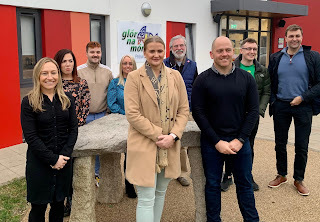 Cro�� na Carraige - Investing in our young
Cro�� na Carraige - Investing in our young
Recently I met with activists involved in the Gl��r na M��na project in west Belfast. Along with the local MLA Aisling Reilly they briefed us on their work in the field of youth provision through the medium of Irish. Gl��r na M��na was established in 2004 and since then has gone from strength to strength. The enthusiasm of its activists reflects the growth in the numbers of people who now conduct their everyday business and social life through Irish. This is especially true of the Irish medium education sector.
In 1971 the first Bunscoil was opened on the Shaws Road in west Belfast with nine pupils. Today there are pre-school, primary level and secondary level schools across the North accommodating almost 7,000 children.
Gl��r na M��na has pioneered Irish-medium youth-work and now caters fro 450 young people each week across the city. Among other projects it has also established are several dealing with local community history and heritage recovery.
Since June 2016 it has operated from its own community hub, Gael-Ionad Mhic Goill, just off the Whiterock Road in the City which was funded by the Irish Language Investment Fund (Ciste), Belfast City Council and the Department for Communities. The following year it was awarded the prestigious, All Ireland Pride of Place Award and the National Gl��r na nGael Main Prize as the most effective Irish language organisation in Ireland. But these successes and a dramatic increase in its work in the Irish medium youth sector quickly saw the organisation outgrow the existing centre.
Consequently, our conversation with them focussed on the next stage in the development of Gl��r na M��na ��� the construction of an exciting multi-purpose youth, community, family and heritage hub ��� Croi na Carraige - on the Belfast City Council owned waste ground adjacent to them.
The new facility would create space for Irish speaking families, adult education projects for all ages, community festivals; arts and culture event, including space for concerts, lectures and films.
Gl��r na M��na appointed an Integrated design team and have produced an ambitious draft design for the Cro�� na Carraige project that maximises the space on the waste ground adjacent to the Gaelionad and opens up opportunities for the Upper Springfield community that will cover the next 20 years. They have funding for an Economic Appraisal and will commence this work before Christmas.
Aisling and I came away from our meeting with the Gl��r na M��na team hugely impressed by their commitment to providing first class youth services for young people through the medium of Irish. Aisling will be meeting them again next month along with Minister Deirdre Hargey who has committed to looking at funding opportunities.
At our cruinni�� in Gl��r na M��na I noticed a Pop Up advertising one of the projects Gl��r na M��na is pioneering. `Faoi Sc��th an tSl��ibhe- Connecting People and Place in the Upper Springfield Area��� is a heritage project aimed at making local history vibrant and accessible. The Pop Up contained a photo of the Number Eleven bus wending its way along the Whiterock Road. That brought back many happy memories. I used to work in The Duke of York pub in Commercial Court off Lower Donegall Street in the late 1960s. I was a regular passenger on the Eleven bus when I wasn't on my bike or my Honda 50.
Jimmy Keaveney was the boss in The Duke���s. Well his mother, Mrs Keaveney was the real boss. She lived upstairs, above the main bar but by the time I landed there as a young curate Jimmy ran the place. He was a decent man. I liked working in The Dukes. The customers were welcoming and interesting. Newspaper men and women from The Newsletter and the BBC. Trade Union officials. Communist Party activists. Old Labour Party stalwarts. Some of Belfast���s republican leaders. Musicians, locals and visitors. And ordinary decent drinkers. Plenty of singing on Friday and Saturday night. In both the lounge and public bars and in a wee converted store room tucked in adjacent to the bar. No party songs. Although Henry Joy marched to the scaffold most weekends and Joe Hill went on to organise as well.
After closing time and the place was cleaned up I would dander around to Castle Street for the last bus home. Number Eleven was the last one going up the Falls and the Whiterock Roads. If I was taking the bus to work in the mornings I usually got the one down the Springfield Road. It stopped at New Barnsley up from and opposite the steps at the top of our street, Divismore Park. But at night it was Number Eleven. The buses used to be trolley buses and before that trams.
The last Number 11 bus on a Saturday night was special. All human life was there. Mostly with drink taken. Pretty girls. Old lads with carry outs of Guinness in stout little brown paper bags. Or a bottle of Mundies. Or Drawbridge. A flagon of Cider from Coyles in Hasting Street. Younger folks with fish suppers wrapped in newspaper or Scallops from Raffos. Scallops are deep fried slices of potatoes. Couples returning from a night out at the pictures. Or maybe a dance or a C��ili. Smoking was permitted upstairs. It enveloped everything. There was an overpowering smell of salt and vinegar, stale smoke, sweat, perfume, aftershave and pungently scented flatulence.
The last bus was always overcrowded as it left Castle Street. The bus conductor usually ambled up and down the bus collecting fares and dispensing tickets. But on the last bus on Saturday night he sometimes didn't bother. He couldnt move the length of himself. People stood in the aisles and sat on the stairs. Hearty souls crowded on to the platform. These buses had no doors. A pole from floor to ceiling, was the only ���barrier��� between the entrance/ exit and the road. Many a time as I ran to catch the last bus I caught hold of the pole as the bus drew away from the pavement and ran alongside it before gathering myself to hop on board. And I wasn't on my own. Many latecomers risked that dangerous boarding challenge rather than face the long walk home.
And the entertainment was free. A sing song. Elvis. The Beatles. Bridie Gallagher. Tom Jones. Perry Como. Frank Sinatra. Percy French. Maybe a subversive offering of The Merry Ploughboy or We Shall Overcome. At times it seemed like the bus swayed from side to side in harmony with the singing. Lots of slegging as the bus slowly discharged its load of human beings at Albert Street, Leeson Street, the Pool, Iveagh and Beechmount, then St James and the Rock Streets before swinging right at the City Cemetery and up the sharp incline past the long grey wall at McCrory Park before stopping opposite Whiterock Drive to dislodge Whiterockians. By then only Ballymurphians or Turf Lodgers were left along with the odd straggler from New Barnsley.
Eventually the Top of the Rock and a right turn onto the Springfield Road and right again into the terminus at Divismore Crescent where the last of us disembarked, bade our good nights and went home. Or if we were lucky off to somewhere else to finish our choral journey in comfort. Yes the Number Eleven Bus was the transport of choice for most of the Ballymurphy travelling proletariat.
Then 1969 came along and that was the end of that.
The Number Eleven Bus: Croí na Carraige - Investing in our young
 Croí na Carraige - Investing in our young
Croí na Carraige - Investing in our young
Recently I met with activists involved in the Glór na Móna project in west Belfast. Along with the local MLA Aisling Reilly they briefed us on their work in the field of youth provision through the medium of Irish. Glór na Móna was established in 2004 and since then has gone from strength to strength. The enthusiasm of its activists reflects the growth in the numbers of people who now conduct their everyday business and social life through Irish. This is especially true of the Irish medium education sector.
In 1971 the first Bunscoil was opened on the Shaws Road in west Belfast with nine pupils. Today there are pre-school, primary level and secondary level schools across the North accommodating almost 7,000 children.
Glór na Móna has pioneered Irish-medium youth-work and now caters fro 450 young people each week across the city. Among other projects it has also established are several dealing with local community history and heritage recovery.
Since June 2016 it has operated from its own community hub, Gael-Ionad Mhic Goill, just off the Whiterock Road in the City which was funded by the Irish Language Investment Fund (Ciste), Belfast City Council and the Department for Communities. The following year it was awarded the prestigious, All Ireland Pride of Place Award and the National Glór na nGael Main Prize as the most effective Irish language organisation in Ireland. But these successes and a dramatic increase in its work in the Irish medium youth sector quickly saw the organisation outgrow the existing centre.
Consequently, our conversation with them focussed on the next stage in the development of Glór na Móna – the construction of an exciting multi-purpose youth, community, family and heritage hub – Croi na Carraige - on the Belfast City Council owned waste ground adjacent to them.
The new facility would create space for Irish speaking families, adult education projects for all ages, community festivals; arts and culture event, including space for concerts, lectures and films.
Glór na Móna appointed an Integrated design team and have produced an ambitious draft design for the Croí na Carraige project that maximises the space on the waste ground adjacent to the Gaelionad and opens up opportunities for the Upper Springfield community that will cover the next 20 years. They have funding for an Economic Appraisal and will commence this work before Christmas.
Aisling and I came away from our meeting with the Glór na Móna team hugely impressed by their commitment to providing first class youth services for young people through the medium of Irish. Aisling will be meeting them again next month along with Minister Deirdre Hargey who has committed to looking at funding opportunities.
At our cruinniú in Glór na Móna I noticed a Pop Up advertising one of the projects Glór na Móna is pioneering. `Faoi Scáth an tSléibhe- Connecting People and Place in the Upper Springfield Area’ is a heritage project aimed at making local history vibrant and accessible. The Pop Up contained a photo of the Number Eleven bus wending its way along the Whiterock Road. That brought back many happy memories. I used to work in The Duke of York pub in Commercial Court off Lower Donegall Street in the late 1960s. I was a regular passenger on the Eleven bus when I wasn't on my bike or my Honda 50.
Jimmy Keaveney was the boss in The Duke’s. Well his mother, Mrs Keaveney was the real boss. She lived upstairs, above the main bar but by the time I landed there as a young curate Jimmy ran the place. He was a decent man. I liked working in The Dukes. The customers were welcoming and interesting. Newspaper men and women from The Newsletter and the BBC. Trade Union officials. Communist Party activists. Old Labour Party stalwarts. Some of Belfast’s republican leaders. Musicians, locals and visitors. And ordinary decent drinkers. Plenty of singing on Friday and Saturday night. In both the lounge and public bars and in a wee converted store room tucked in adjacent to the bar. No party songs. Although Henry Joy marched to the scaffold most weekends and Joe Hill went on to organise as well.
After closing time and the place was cleaned up I would dander around to Castle Street for the last bus home. Number Eleven was the last one going up the Falls and the Whiterock Roads. If I was taking the bus to work in the mornings I usually got the one down the Springfield Road. It stopped at New Barnsley up from and opposite the steps at the top of our street, Divismore Park. But at night it was Number Eleven. The buses used to be trolley buses and before that trams.
The last Number 11 bus on a Saturday night was special. All human life was there. Mostly with drink taken. Pretty girls. Old lads with carry outs of Guinness in stout little brown paper bags. Or a bottle of Mundies. Or Drawbridge. A flagon of Cider from Coyles in Hasting Street. Younger folks with fish suppers wrapped in newspaper or Scallops from Raffos. Scallops are deep fried slices of potatoes. Couples returning from a night out at the pictures. Or maybe a dance or a Céili. Smoking was permitted upstairs. It enveloped everything. There was an overpowering smell of salt and vinegar, stale smoke, sweat, perfume, aftershave and pungently scented flatulence.
The last bus was always overcrowded as it left Castle Street. The bus conductor usually ambled up and down the bus collecting fares and dispensing tickets. But on the last bus on Saturday night he sometimes didn't bother. He couldnt move the length of himself. People stood in the aisles and sat on the stairs. Hearty souls crowded on to the platform. These buses had no doors. A pole from floor to ceiling, was the only ‘barrier’ between the entrance/ exit and the road. Many a time as I ran to catch the last bus I caught hold of the pole as the bus drew away from the pavement and ran alongside it before gathering myself to hop on board. And I wasn't on my own. Many latecomers risked that dangerous boarding challenge rather than face the long walk home.
And the entertainment was free. A sing song. Elvis. The Beatles. Bridie Gallagher. Tom Jones. Perry Como. Frank Sinatra. Percy French. Maybe a subversive offering of The Merry Ploughboy or We Shall Overcome. At times it seemed like the bus swayed from side to side in harmony with the singing. Lots of slegging as the bus slowly discharged its load of human beings at Albert Street, Leeson Street, the Pool, Iveagh and Beechmount, then St James and the Rock Streets before swinging right at the City Cemetery and up the sharp incline past the long grey wall at McCrory Park before stopping opposite Whiterock Drive to dislodge Whiterockians. By then only Ballymurphians or Turf Lodgers were left along with the odd straggler from New Barnsley.
Eventually the Top of the Rock and a right turn onto the Springfield Road and right again into the terminus at Divismore Crescent where the last of us disembarked, bade our good nights and went home. Or if we were lucky off to somewhere else to finish our choral journey in comfort. Yes the Number Eleven Bus was the transport of choice for most of the Ballymurphy travelling proletariat.
Then 1969 came along and that was the end of that.
December 5, 2021
Six of The Best: An opinion poll on Unity: Standing with Palestinians
Six of The Best.
I’m reading Colin Broderick’s ‘That’s That,’ an evocative account of growing up in Altnamuskin in Tyrone at the height of the conflict. Colin’s mother and her efforts to protect her brood are at the heart of this story. Her ‘That’s That’ as she lays down the law and the final words in any dispute with young Colin, gives this book its title.
In one little cameo Colin tells of getting ‘slapped’ at school. He describes the strap as ‘a twenty inch length of thick leather about an inch and a half wide, worn smooth from years of skin contact.’ He goes on to describe how the teacher ordered him to hold his hand out, palm upwards as he struck him forcefully across the hand with the strap.
By coincidence Richard and I were discussing corporal punishment a few days before I read this. I don’t recall how that came into the conversation but that’s the way with conversations between Richard and me. They are inclined to meander. When I read Colin’s account of being slapped I was back again getting called to the front of the class while the teacher fetched his strap from the drawer in his desk and ordered me to extend my hand. Whack. Whack. Two slaps was the normal punishment for messing about in class. One on each hand. Six of the best was reserved for more serious offences like giving cheek to the teacher.
The first slap was always the worst. There was an initial shock as the strap met your extended palm. Sometimes the leather caught you across the fingers. After that the hand went numb except when the strap caught your thumb. That left your hand stinging and brought tears to your eyes. Some boys cried. I was stubborn. I also didn't get slapped too often. Sometimes a teacher would yank a boy to his feet by grabbing his ear lobe. Or the lock of hair alongside his ear. Some threw objects at boys they suspected of messing about. The blackboard cleaner with its wooden base was a favourite projectile. So were rulers. Usually made of wood. Sometimes they were used instead of straps.
Corporal punishment was the norm in those days. In the home as well as schools. Although more enlightened teachers or parents would not dream of striking a child. Corporal punishment was also part of community ‘justice’ during the conflict. We are all capable of striking out in anger or pain. When we are provoked. Or under threat. When our loved ones are under threat. There are few saints among us. Or pacifists. But it’s good that corporal punishment is no longer tolerated in our schools or anywhere else.
Managing a class of unruly boys, or girls, is a challenge. Teachers do their best. Nowadays. As well as back in the day. Most of us can name a teacher who made a positive difference in our lives.
When Richard and I were discussing these matters I asked him who supplied the straps. Richard, who was a student teacher, didn't know. He says he never slapped anyone. His incarceration in Long Kesh saved young scholars from that indignity. Saved Richard also?
But who made the straps. Local cobblers? There were local cobblers in those days. Or were they supplied centrally? Did the Brothers have a special supply? Was there a template? A recommended size, shape or length of strap. Was slapping part of teacher training? Were young teachers advised on what ‘offences’ warranted slaps? Was there guidance on how many slaps were appropriate?
‘That’s That’: by Colin Broderick, published by BroadwayPaperbacks.com
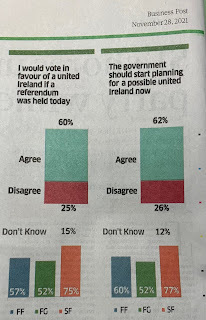
An opinion poll on Unity
Opinion polls are no more than a glimpse into the public mood at a given moment. They can change dramatically and for those who are doing well in party political opinion polls they are no guarantee of success in a future election. That’s why I rarely pay too much heed to them.
Last weekend a Red C poll for the Sunday Business Post looked at public attitudes in the South to the issue of a United Ireland, a Citizen’s Assembly and other matters. For those campaigning for Irish Unity the poll confirms that the debate on unity has increased and is a priority issue for many people.
Despite the refusal of An Taoiseach Micheál Martin to plan for or organise a considered discussion on the issue of unity 60% of people polled are ready to vote in favour of a united Ireland today. 62% also believe that the Irish government should start planning for a united Ireland now. I am not surprised by this. It has consistently been my view that the majority of people in the South are for unity. The details and conditions are a different matter. But most favour an end to partition and self government for the people of the island. That has been my experience.
Micheál Martin has point blank refused to hold a Citizen’s Assembly to discuss the entire myriad of issues that must inevitably be part of any discussion on unity. 65% of those polled believe that it should be established. Other matters such as the flag, the anthem, the place of unionists in a cabinet, the continuation of power sharing in the North in the new Ireland, all point to some of the matters about which there is no clear view.
This is entirely reasonable. Reunification is a big step. Merging two economies; tax systems; health systems; education systems; planning for the environment in the midst of a climate crisis; accommodating the many different views of what the new Ireland should look like and in particular the warm place for unionists within it, are all huge issues that point to the need for dialogue and a willingness to compromise.
Only a planned conversation, involving all of those who wish to participate, can hope to find solutions to these issues. One thing is for sure. We republicans are not about the south taking over the north or vice versa. We are about self determination and a new society, citizen centred and rights based. A genuinely new Ireland based on equality.
The Red C Poll is more evidence that the issue of Irish unity is now front and centre and the Irish government cannot continue to hide from it.
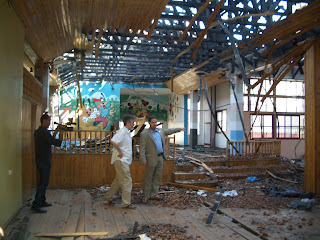 Visiting a hospital bombed by Israel 2009
Visiting a hospital bombed by Israel 2009
Standing with Palestinians
Monday was International Day of Solidarity with Palestine. Solidarity vigils and demonstrations took place in Belfast, in many other parts of Ireland and around the world. These acts of solidarity are very important. They are a reminder to the Palestinian people that they are not alone. Despite the many governments who continue to shamefully ignore the brutality of the Israeli apartheid system, and the ill-treatment of the Palestinian people, there are millions of people who empathise with and support their efforts to achieve freedom and self-determination.
The challenges facing the Palestinian people are enormous. In April of this year Human Rights Watch published a scathing report on the policies and actions of the Israeli state. In ‘A Threshold Crossed – Israeli Authorities and the Crimes of Apartheid and Persecution’ it became the first major international human rights organisation to accuse Israel of committing the crime of apartheid and of responsibility for crimes against humanity.
It concluded that in its determination to maintain control over the Palestinian people, their land and resources, Israel has ‘dispossessed, confined, forcibly separated, and subjugated Palestinians by virtue of their identity to varying degrees of intensity. In certain areas, as described in this report, these deprivations are so severe that they amount to the crimes against humanity of apartheid and persecution.’
Israel’s response has been to escalate its repression. Two months ago it accused six well known, internationally respected human rights groups, many funded by the United Nations, the European Union and some by the Irish government, of being terrorist organisations. The six organisations are Addameer, which focuses on providing support for the 4650 political prisoners; 500 internees; 160 children held in Israeli prisons and 34 women prisoners.
Other groups impacted are Al-Haq, which has special consultative status with the United Nations Economic and Social Council; the Bisan center for research and development; the Union of Agricultural Work Committees; and the Union of Palestinian Women’s Committees.
The child rights organisation Defense for Children International-Palestine is one of those outlawed. It is part of the Defence for Children International (DCI), an international child-rights movement. As part of DCI it holds consultative status on the United Nations Economic and Social Council, UNICEF, UNESCO, and the Council of Europe. In its work it highlights the continued imprisonment of children by the Israeli authorities. Its’ most recent statistics reveal that 27 children are in solitary confinement; there have been over 70 children killed this year; and there are 160 child detainees.
The Israeli human rights group B’tselem, which expressed its solidarity ‘with our Palestinian colleagues’ described the Israeli government’s assault on these human rights groups as ‘an act characteristic of totalitarian regimes, with the clear purpose of shutting down these organisations.’ Human Rights Watch and Amnesty International condemned the actions of the Israeli government.
Crucially, the investigative work of the six banned organisations has contributed to the case to open criminal investigations by the International Criminal Court (ICC) against Israel. In March the ICC announced its decision to begin a criminal investigation.
There can be little doubt that the banning of the six Human Rights groups is an attempt to silence Palestinian organisations that would provide evidence to the ICC’s investigation. The solidarity protests on Monday are a reminder to the Palestinian people that they are not alone and to the Israeli authorities that however hard they oppress the Palestinian people there is widespread international support for them.
November 28, 2021
Gaels call for Citizens Assembly: Back off Boris: An Irish National Health Service
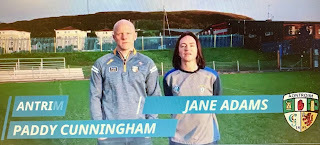 Gaels call for Citizens Assembly
Gaels call for Citizens Assembly
In a powerful video message 12,000 Ulster Gaels are appealing to our fellow Gaels in Munster, Leinster and Connaught to sign and endorse a letter to An Taoiseach Micheál Martin asking the Irish government to take the lead in planning for Irish Unity by establishing an All-Island Citizens Assembly “reflecting the views of citizens North and South to achieve maximum consensus on a way forward” toward an “agreed shared Ireland.”
The letter states: “It is the responsibility of the Irish government to ensure that the democratic rights of all citizens are respected and protected, regardless of where they live on the island … “
The letter to Micheál Martin was an idea that first emerged in Antrim earlier this year. Since then it has spread across the nine counties of Ulster and has gathered over 12,000 signatures. The campaign has also gained substantial support in the other three provinces.
Down’s double All-Ireland winner Ross Carr said that he has been overwhelmed by support since he started seeking support for the campaign. He said: “I asked people from all walks of life – doctors, barristers, former players, administrators, ordinary supporters – and it was incredible the amount of support for this initiative.”
Paul Gibbons who coaches Cremartin Shamrocks GAA in Monaghan is one of those behind the efforts in that county to secure more signatures for this initiative. He told his local paper the Northern Standard: “The purpose of the letter is to highlight the growing conversation taking place in communities the length and breadth of our island about the future constitutional direction of this island and to provide a platform for Gaels throughout the county to engage in that conversation.”
He added: “Our letter articulates three main asks of the Irish government – to take the lead in the planning for a future border poll and start the planning for the future re-unification of this island; to establish a Citizen’s Assembly and to protect the rights of all citizens.”
Thus far An Taoiseach Micheál Martin has refused to comment on the initiative or respond to the letter which he first received in May. But as it says in the video – Ní neart go cur le chéile. There is strength in Unity.
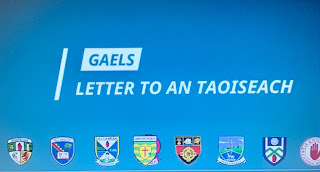 Pádraig Hampsey is captain of the All Ireland Champions Tyrone. He has appealed to fellow Gaels to join in this effort, and to sign up to the letter at: www.gaelslettertotaoiseach.ie
Pádraig Hampsey is captain of the All Ireland Champions Tyrone. He has appealed to fellow Gaels to join in this effort, and to sign up to the letter at: www.gaelslettertotaoiseach.ie
So, if you have a minute click on to #gaelsletter and watch the amazing video of GAA greats asking you for your help and support in building a better future for all of our people.
Back off Boris
 Comhgairdheas to the many hundreds of people who took part in a series of protests against Brexit along the border last Saturday. The ‘Border Communities Against Brexit’(BCAB) has been very effective in raising awareness around the threat to the Good Friday Agreement, to the economy of the island of Ireland and especially to the border communities, posed by Brexit. Saturday’s event at Carrickcarnon had activists dressed in customs officer’s clothes and a recreation of the old customs huts that used to sit along the border corridor. But beyond the theatrics the message was clear and vitally important.
Comhgairdheas to the many hundreds of people who took part in a series of protests against Brexit along the border last Saturday. The ‘Border Communities Against Brexit’(BCAB) has been very effective in raising awareness around the threat to the Good Friday Agreement, to the economy of the island of Ireland and especially to the border communities, posed by Brexit. Saturday’s event at Carrickcarnon had activists dressed in customs officer’s clothes and a recreation of the old customs huts that used to sit along the border corridor. But beyond the theatrics the message was clear and vitally important.
‘Protect the Protocol’ and ‘Back off Boris’ were the two main themes for the five protests that took place at Carrickcarnon; Belcoo/Blacklion; Aughnacloy; Lifford Bridge and Bridgend, Derry. The message from all of the speakers was the same. Firstly, a warning to Boris Johnson not to trigger Article 16. Secondly, a demand that every effort must be made by the EU and the Irish government to defend the Protocol and the Good Friday Agreement.
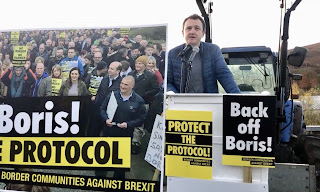 Colin Harvey, who is professor of Human Rights Law at Queen’s University told the crowd: “The Protocol mitigates the damage that the British Brexiteers want to impose on this island … what is scandalous is the lack of discussion about the opportunities that the Protocol provides for all the people of the North.”
Colin Harvey, who is professor of Human Rights Law at Queen’s University told the crowd: “The Protocol mitigates the damage that the British Brexiteers want to impose on this island … what is scandalous is the lack of discussion about the opportunities that the Protocol provides for all the people of the North.”
The Chair of BCAB Damian McGenity reminded those at the protest that the majority of citizens in the North voted to remain in the EU and that a majority of their political representatives support the Protocol. He pointed too to the benefits of the Protocol. Evidence of this emerged last week in the latest statistics on trade from the Central Statistics Office in Dublin which showed that the value and amount of trade between the North and the South has increased dramatically.
In the first nine months of this year trade North to South has increased by 60 per cent and from South to North by 48 per cent in the same period. In money terms exports from the North to the South have so far increased in 2021 by €1,061m (£897m) to €2,822m (£2,385m). Trade South to North has jumped by €835m (£706m) to €2,577m (£2,178m).
In addition the advantage for the North of having open access to the EU and to the British market has seen several important new job announcements. Ardagh Metal Packaging announced its intention to invest $200m and create 170 jobs in a new beverage can plant near Belfast. The pharmaceuticals group, Almac, also announced that it is going to create 1,000 jobs over the next three years.
Meanwhile in the British Parliament the DUP’s Ian Paisley engaged in the kind of hyperbole unionist leaders seeking to frighten and intimidate their supporters have used for generations. According to Paisley the Protocol is being used by Brussels to “destroy this part of the United Kingdom by insisting on the enforcement of a protocol in a disgraceful manner." And he demanded that the Johnson government "Invoke Article 16 and invoke it now, and stop dillydallying on this issue. Put business out of the misery in Northern Ireland."
This kind of doomsday rhetoric has no basis in fact. On the contrary triggering Article 16 would open up the real likelihood of a trade war between the British government and the EU with the North caught in the middle. According to a report in the Financial Times many businesses in the north are “filled with dread at the prospect of yet more disruption and uncertainty if Article 16 was triggered.”
BCAB is leading the way in challenging the British government, the DUP and others who have chosen to ignore the democratic vote of the people. Last week Sinn Féin hosted over 180 business representatives to discuss the economic opportunities created by the Protocol and the potential for greater investment and more jobs arising from Irish Unity. They and we are looking to a better future, a more prosperous future. God speed the Day.
An Irish National Health Service
The Proclamation of 1916 states that the Republic guarantees … “equal rights and equal opportunities to all its citizens, and declares its resolve to pursue the happiness and prosperity of the whole nation … cherishing all the children of the nation equally …” It doesn’t say except for those who have a disability, or are sick, or who have mental health issues, or who need an operation.
Recent statistics reveal that over 900,000 people in the South are on a hospital waiting list. At the current rate the number will soon top one million. In the North a report last month noted that 348,867 people are waiting for a first consultant appointment – an increase of almost 40,000 over last year.
There are lots of reasons for these appalling stats. Mostly it’s as a result of under-investment and under capacity within the health systems and in the South by decisions taken by successive Fianna Fáil and Fine Gael governments. In the last 20 years, since Micheál Martin was Minister for Health in 2000, there have been eight Health Ministers from these two parties. All have promised an end to the crisis in the health service. They have all failed.
When I was a TD in Louth I learned very quickly that every winter Our Lady of Lourdes hospital in Drogheda was going to come under huge pressure.
In the North the crisis in the Health Service is exacerbated by the fact that the purse strings are held by London and the Tories have been hell bent on privatisation for years. So too is the FFFG coalition in Dublin.
Covid has added to this very real crisis in our two health services one result of which is that patients urgently needing treatment for life threatening illnesses such as cancer are waiting longer than advisable for appointments and treatment.
The answer in the short term at this time in our history is for as much all-island cooperation and coordination as practicable to make best use of available limited resources. In the longer term we need an Irish National Health Service that is free at the point of access and is sufficiently funded to meet the health needs of citizens. This isn’t pie in the sky. This is a realizable, achievable objective. It just needs political will.
November 22, 2021
Rewriting History; Ratcheting up the Brexit crisis; Day of Action
Rewriting History
“The first casualty when war comes is the truth” said US Senator Hiram Johnson in 1917. We know only too well from our own recent experience of reporting on the decades of conflict how true this is. However, it misses the equally important other side of the coin – the victor writes the history.
The narrative of European colonialism, and especially of the British Empire, is full of examples of this. The British public today still believes that the Empire was great! While those in Ireland, in Africa, in India and elsewhere who suffered from its exploitation and brutality see it as a thief, an exploiter, a mass murderer, the purveyor of famine and poverty.
The English claim they came to Ireland to civilise the barbarians. Colonial and western powers often use the excuse to justify their colonial occupation and military interventions. In recent years this was evident again in Iraq, in Afghanistan and in Libya. The French philosopher and writer Jean Paul Sarte described it well: “Terror and exploitation dehumanise, and the exploiter authorises himself with that dehumanisation to carry his exploitation further.”
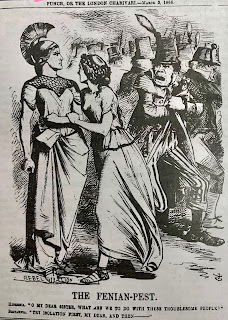 In the 19th century British strategy in Ireland was based on this approach. We Irish were the problem. They, the British were the solution. The British state presented the Irish as ape-like in order to justify its use of coercion. O’Connell who was leading a campaign to end the Union with Britain was described by the Times as “scum condensed of Irish bog” and a “greedy self-serving Satan.” In 1846 in justification of even greater coercion the Times wrote: “The great obstacle to tranquillity in Ireland is the national character – the character of the masses of the middle classes, of the senators of Ireland … When Ireland acts according to the principles of civilised man then she can be ruled by the laws of civilised man.” The 19th century saw Coercion Acts passed every year by London to maintain its domination.
In the 19th century British strategy in Ireland was based on this approach. We Irish were the problem. They, the British were the solution. The British state presented the Irish as ape-like in order to justify its use of coercion. O’Connell who was leading a campaign to end the Union with Britain was described by the Times as “scum condensed of Irish bog” and a “greedy self-serving Satan.” In 1846 in justification of even greater coercion the Times wrote: “The great obstacle to tranquillity in Ireland is the national character – the character of the masses of the middle classes, of the senators of Ireland … When Ireland acts according to the principles of civilised man then she can be ruled by the laws of civilised man.” The 19th century saw Coercion Acts passed every year by London to maintain its domination.
Following partition successive British governments and media ignored the institutionalised discriminatory and sectarian policies used by the Ulster Unionist Party to maintain its control.
During the years of conflict that followed the rejection by Stormont of the civil rights very modest demands the British state and its military attempted to manage the news. General Frank Kitson, Britain’s leading counter insurgency expert wrote: “the press properly handled is one of the government’s strongest weapons.”
Many programmes were banned.The lie used by the establishments North and South was that the British Army was needed to prevent civil war between Catholics and Protestants. This narrative helped fuel the years of war. It made the job of dialogue and conversation almost impossible. Sinn Féin was dehumanised and by extension anyone who spoke to us was the target for vilification. John Hume endured huge criticism for daring to talk to me about peace. The Dublin establishment was outraged. Or pretended to be outraged.
Almost 25 years after the Good Friday Agreement the British establishment is still fighting the war. The spooks and securocrats who run the British system know the IRA was not defeated. Instead they facilitated and supported the peace process. This is not acceptable to the war mongers and their cheerleaders on the British side. They are also worried that the historic narrative is increasingly exposing Britain’s illegal and violent actions during those years. In addition, the fact that Sinn Féin is in government in the North and might well lead a government in Dublin in the near future is intolerable to them.
It therefore came as no surprise when the London Telegraph revealed at the weekend that the British government is to commission a history of the ‘troubles’ beginning in the 1960s up to the signing of the Good Friday Agreement. The Telegraph story states that this idea comes from Britain’s colonial office in the North – the Northern Ireland Office (NIO) – and that London will appoint a group of historians to write this official history. This group of historians, appointed by the government, will they claim, be independent of the government. Mar dhea!
Censorship and bias in the reporting of events and the interpretation and analyses of those events is a powerful weapon in any government’s arsenal. It allows it to shape attitudes in society in its own interests.
British governments are especially good at this. On the one hand they pose as the defenders of free speech and democratic change while imposing censorship or restricting debate and refusing change when it suits their national interests.
So, on the 19 October 1988 Margaret Thatcher introduced censorship restrictions on Sinn Féin. Our voices could no longer be heard. Several days later the same Thatcher visited Poland where she lectured the Polish government on the merits of openness: “In modern societies, success depends upon openness and free discussion. Suppress those things, and you are unable to respond to the need for change.”
Of course, Thatcher was not alone in employing this hypocritical policy. Successive Irish governments imposed Section 31. The effect of state censorship was pernicious. It rolled over into a revisionist history of recent Irish history which encouraged partitionism.
The British government’s current effort to close down legacy cases is an example of this hypocrisy. The right of families and victims to truth are being set aside through the introduction of a statute of limitations. The British state is intent on hiding the criminal actions of its state forces and its use of state collusion with state sponsored murder gangs.
However hard the British government seeks to do this; however many revisionist historians they employ to bolster Britain’s view of history, the case of Pat Finucane; the importation by British intelligence of South African sourced weapons for Loyalist groups; the three reports by John Stevens; the role of state agents like Brian Nelson, and of the Glenanne Gang; the deaths of hundreds of victims; and the countless official reports by the Ombudsman and others into state collusion, will continue to haunt the British government. No amount of historical revisionism will change this.
Ratcheting up the Brexit crisis
For those of you unfamiliar with the language of Brexit, Article 16 is the legal mechanism within the Irish Protocol which can be triggered if the Protocol is creating serious "economic, societal or environmental difficulties" that are liable to persist. This would involve one side or the other unilaterally suspending parts of the deal.
The British government has been claiming for months that the bar for invoking Article 16 was reached in the summer. In his efforts to heighten the sense of crisis Jeffrey Donaldson has repeatedly demanded that the British invoke Article 16 if the EU do not concede to London’s demands. Loyalist groups have hijacked several buses and the Progressive Unionist Party says there is no longer a basis for unionists supporting the Good Friday Agreement. The threat of violence is being consciously whipped up by some in unionism to raise tension and leverage concessions from the EU.
In contrast a University of Liverpool survey found that most unionists do not regard the Protocol as a priority concern.
More significantly last week four senior U.S. Democrats who chair major Congressional Committees - Gregory W. Meeks, Chair of the House Foreign Affairs Committee; William R. Keating, Chair of the Europe, Energy, the Environment and Cyber Subcommittee; Earl Blumenauer, Chair of the Ways and Means Subcommittee on Trade, and Brendan Boyle, Chair of the European Union Caucus, - issued a joint statement in which they called on the British government to end its threat to use Article 16. The four US politicians warned that the full implementation of the Protocol is “critical for ensuring Brexit doesn’t undermine decades of progress toward peace on the island of Ireland."
Adding to the pressure on the Johnson government the European Commission president Ursula von der Leyen met President Biden in the White House also last week and emerged saying that the EU has the support of the United States. Von der Leyen told journalists that the EU and the USA share the assessment that “it is important for peace and stability on the island of Ireland to keep the withdrawal agreement and to stick to the protocol.”
But for now the DUP and Johnson still appear determined to create a real crisis with the EU. London has set a December deadline for a deal with the EU on British terms. Will they won’t they trigger Article 16 as part of this process? We should know soon.
Day of Action
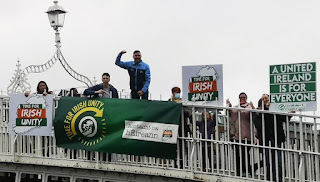
Well done to everyone who participated in last Saturday’s Day of Action in Belfast and Dublin which promoted the theme – Unity in Our Time. The new Bobby Sands mural was officially unveiled on the International Wall in Divis Street. It is based on a photo of Bobby taken at the first major political status march in August 1976 and is set against the backdrop of the Black Mountain. There were white line pickets across Belfast and Dublin City, as well as on the Ha’penny Bridge on the Liffey.
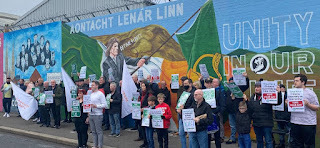
November 15, 2021
How I got a different view of Croker; First World problems need fixed: TG4 - here's to another 25 years
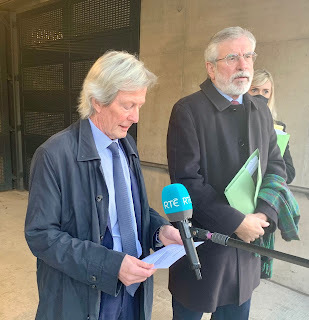
How I got a different view of Croker
Last week I spent a day in Croke Park. I have been there many times before. Usually for GAA fixtures or the occasional concert. But last week was different. Some of the courts service in Dublin, including defamation cases, are currently being heard there. The Covid restrictions meant shifting some cases out of the Four Courts. Croke Park is an unusual setting for court business. Looking out of the window on level five at the green pitch down below while lawyers, potential jurists, court officials and others were busily rushing about their business.
My case had to do with an article in the Sunday World in September 2015. In May that year Jock Davison was killed as he walked to work. Several months later on 13 August Kevin McGuigan was shot dead outside his home. As a result there was a huge political storm as some politicians tried to link republicans to these events. The DUP wanted Sinn Féin expelled from the institutions and threatened to leave the Executive. On 10 September Peter Robinson announced that he was standing aside as First Minister along with other DUP Ministers and leaving Arlene Foster as their sole Ministerial representative in the Executive. He said that he had “stepped aside but technically not resigned.”
Three days later the Sunday World published a story under the heading – “Gerry’s Secret McGuigan Meeting – Adams met murdered Provo over hit-threat fears’ which claimed that I had met Kevin McGuigan in July and assured him that he was not “under any threat from Sinn Féin members.”
The story was untrue. I had not met Kevin McGuigan. I said so publicly and immediately contacted my solicitor and commenced proceedings against the Sunday World. That was six years ago.
Last Tuesday the Sunday World’s legal representative read out an apology in the court. It said: “Although the Sunday World reported the existence of such a meeting in good faith, we now accept Mr. Adams’s position that no such meeting or conversation ever took place and have agreed to publish this apology for the record.”
Outside Croke Park my solicitor Paul Tweed described the front page story and the two prominent pages inside the paper as sensationalised and “making totally false and spurious claims”. Paul Tweed said: “Not only had this allegation been totally untrue but the defendant (Sunday World) failed to come up with any evidence or basis for the unfounded story. The publishers of the Sunday World have finally and belatedly acknowledged what they have done and retracted the allegations and unreservedly apologised to Mr. Adams before the court this afternoon.”
I took the opportunity to thank Paul Tweed and Johnsons and the senior counsel.
I told the waiting media: “For a long time now some elements of the media have reported or published or made very false and vicious and offensive claims about me and about other republicans. I am satisfied in this case that the Sunday World has apologised for this deeply offensive and false article. I am also very conscious that at the very centre of it a man, Kevin McGuigan murdered and another man Gerard Davison was murdered also. Their families like many others are grieving.”
For me this was always about asserting my own integrity and I think the case succeeded in that. It is my intention to donate the proceeds of the settlement to good causes. These will include the Irish language sector, Green Cross, The Bobby Sands Trust, The Moore Street Preservation Trust, the homeless and other projects that I have a grá for. .
First World problems need fixed Most readers of this column, like this columnist, live in the developed world. So, some of our problems are first world problems. Many of us have benefitted from the advances of recent decades. I am from that generation who spent my childhood in an overcrowded house without basic amenities like a bathroom, inside toilet or hot water. Most of the menfolk in my clann were building labourers, hod carriers, manual workers. Their work was precarious, casual and underpaid. The womenfolk worked in the mills while rearing usually large broods of children. The work was hard, conditions tough and the wages were miserly. The women were the homemakers, dependent on weekly visits to the pawnshop - Paddy Lavery’s in our case - the support of Grannies and the sharing of food with neighbours to supplement meagre incomes. None of our adult family members were educated beyond primary school level. Yet they were intelligent socially aware human beings. Yet all of us were poor. Why? I came to question this as I got older and more aware.
There have been many improvements since then. Nowadays many of us have decent homes, a good quality of life and many of our children and grandchildren are university educated. These basic rights were won because people took a stand.
But not all of us are so lucky. Poverty is still widespread. Some citizens are still treated unfairly. Some children do not have the chance to reach their full potential. So we have to be always mindful that they are in the place we used to be in. We have to rise up with our class not out off it. Poverty is not an accident. It is a consequence of public policy or the lack of it. If we cannot eradicate poverty in this part of the developed world how can we hope to do so in the developing world where poverty is widespread and deeply embedded?
In my view we will not eradicate poverty in Ireland while we are governed by Tories in Dublin and London. Of course we need to keep trying to alleviate hardship and we need to support measures to give people economic rights even though our country is partitioned. But when we end partition and have our own national democracy and the opportunity for a real republic then the struggle enters another phase. A poverty free Ireland has to be the objective of all public policy. That is the best contribution we can make to a poverty free world. The proposition is straight forward. It is called equality. Anything else is unacceptable. Here in the so called developed world or in the developing world. James Connolly put it well: “For our demands most moderate are. We only want the earth.”
Lá breithe TG4.
I don’t watch television that often but when I do TG4 is usually my first choice. It has everything. Its an Irish language channel. The Irish language channel. Great music. Sport. It’s GAA coverage is first class. News. History. Culture. Documentaries, drama, programmes for children and much more. Its series of films telling the stories of the 1916 leaders are among the best ever produced. Its coverage of the centenary of 1916 was excellent. Dramas like An Klondike have attracted world-wide audiences and many awards. Ros na Rún has been running for 26 seasons. The travelogue documentaries which have examined the journeys of the diaspora and their impact on life in the USA and elsewhere have been hugely informative. TG4 has been a creative force in Irish society encouraging local talent and producing programmes to the best international standards.
25 years ago on Halloween evening 1996 Teilifís na Gaeilge was born in Baile na hAbhann, in Connemara. It was a long time coming. Like all efforts to promote the Irish language there was fierce resistance within the political establishment to investing in a television station that in their view would only ever service a minority community. Gaeilgeorí had fought long and hard over many years to get it established and its arrival was applauded by Irish speakers as a positive development here and overseas. However, the battle to defend, protect and expand the use of Gaeilge was not ended by the establishment of Teilifís na Gaeilge. That battle continues today.
Since 1996 Teilifís na Gaeilge, which was rebranded as TG4 in October 1999, has gone from strength to strength. Recently, as part of the celebration of its 25th birthday a new advertising campaign to promote TG4 has commenced. As part of this one of the many advertising hoardings on the Andersonstown Road carried a large message announcing ‘Súil Eile’.
So, well done to everyone involved in TG4 – past, present and in the future. And whether you have Irish, or just a cúpla focal or none at all tune in. You won’t be disappointed.
Gerry Adams's Blog
- Gerry Adams's profile
- 29 followers


